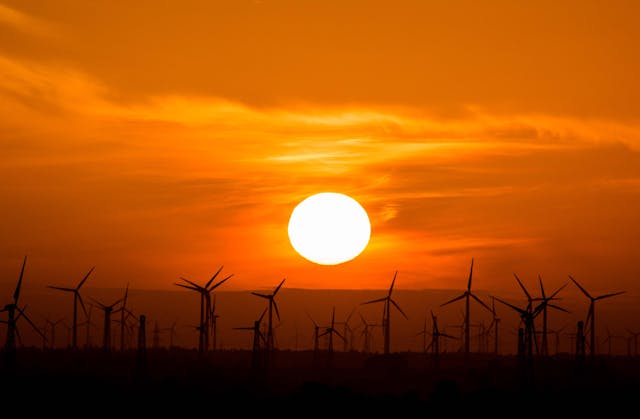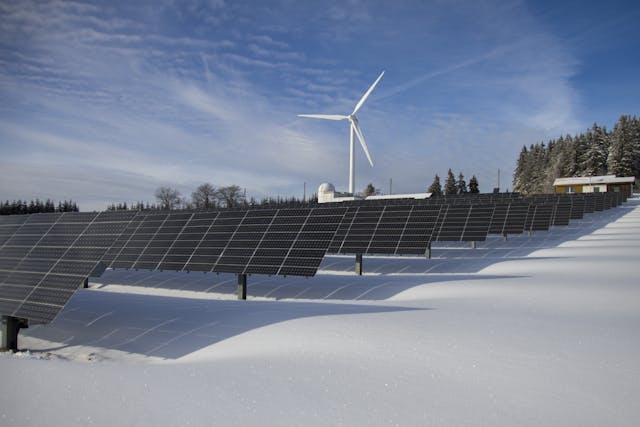Renewable energy is at the forefront of global efforts to combat climate change and create a sustainable future. As we face the challenges of depleting fossil fuel resources and increasing environmental concerns, renewable energy sources offer a clean, inexhaustible, and increasingly competitive way to power our world.
What is Renewable Energy?
Renewable energy comes from sources that are naturally replenishing and virtually inexhaustible in duration but limited in the amount of energy that’s available per unit of time. The main types of renewable energy sources are:
- Solar Energy
- Wind Energy
- Hydroelectric Power
- Geothermal Energy
- Biomass Energy
Let’s explore each of these in more detail:
1. Solar Energy
Solar power harnesses the sun’s energy using photovoltaic cells or solar thermal collectors. It’s one of the fastest-growing renewable energy sources due to declining costs and improving efficiency.
Pros:
- Abundant and accessible
- Low operating costs
- Scalable from small residential to large utility installations
Cons:
- Intermittent (dependent on sunlight)
- Initial installation costs can be high
- Requires significant land area for large-scale production
2. Wind Energy
Wind turbines convert the kinetic energy in wind into mechanical power that can be used for specific tasks or converted into electricity.
Pros:
- Clean and abundant
- Can be built on existing farms or ranches
- Offshore wind farms have significant potential
Cons:
- Intermittent power source
- Visual impact and noise concerns
- Potential impact on wildlife, especially birds and bats
3. Hydroelectric Power
Hydropower uses the energy of flowing water to produce electricity. It’s one of the oldest and largest sources of renewable energy.
Pros:
- Reliable and can respond quickly to energy demands
- Long-lasting installations
- Can provide flood control and irrigation
Cons:
- Environmental impact on local ecosystems
- Potential for methane emissions from reservoirs
- Dependent on sufficient water flow
4. Geothermal Energy
Geothermal energy taps into the Earth’s internal heat for a variety of uses, including electric power production and the heating and cooling of buildings.
Pros:
- Constant and reliable
- Small land footprint
- Low operating costs
Cons:
- Limited to specific geographic locations
- High upfront costs for drilling and installation
- Potential for release of greenhouse gases trapped underground
5. Biomass Energy
Biomass energy comes from burning organic materials like wood, crops, and waste. When managed sustainably, it can be a carbon-neutral energy source.
Pros:
- Can use waste products as fuel
- Potentially carbon-neutral if managed correctly
- Can support agricultural and forestry industries
Cons:
- Can compete with food production for land use
- Emissions from burning biomass
- Requires careful management to ensure sustainability
The Growing Importance of Renewable Energy
Renewable energy is becoming increasingly crucial for several reasons:
- Climate Change Mitigation: Renewable energy sources produce little to no greenhouse gases, helping to reduce our carbon footprint and combat climate change.
- Energy Security: By diversifying our energy sources and reducing dependence on imported fossil fuels, countries can enhance their energy security.
- Economic Benefits: The renewable energy sector is creating jobs and driving economic growth in many regions.
- Technological Advancements: Ongoing innovations are making renewable energy more efficient and cost-competitive with traditional energy sources.
- Health Benefits: Reduced air pollution from the shift to renewables leads to significant public health improvements.

Challenges and Future Outlook
Despite its many benefits, the transition to renewable energy faces several challenges:
- Intermittency: Many renewable sources are not constantly available, requiring advancements in energy storage technologies.
- Grid Integration: Existing power grids need to be updated to handle the variable nature of renewable energy.
- Initial Costs: While becoming more competitive, the upfront costs of renewable installations can still be high.
- Policy and Regulation: Supportive policies and regulations are crucial for driving the adoption of renewable energy.
However, the future of renewable energy looks promising. Costs continue to decrease, efficiency is improving, and global investment in renewables is growing. As we move towards a more sustainable future, renewable energy will play an increasingly vital role in powering our world.
By embracing renewable energy sources and supporting their development, we can create a cleaner, more sustainable energy landscape for generations to come.
